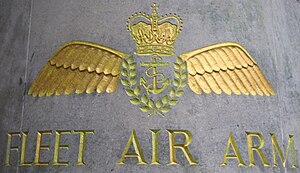Fleet Air Arm
| Fleet Air Arm | |
|---|---|
 |
|
| Founded |
1914 (As the Royal Naval Air Service) |
| Country |
|
| Allegiance | Queen Elizabeth II |
| Branch | Royal Navy |
| Size | 5,000 personnel Approx. 174 aircraft |
| Part of | Royal Navy |
| Engagements |
Second World War Korean War Operation Musketeer (Suez Crisis) Falklands War Gulf War Afghanistan War Iraq War |
| Website | [1]-FAA |
| Commanders | |
| Rear Admiral, Fleet Air Arm | Rear Admiral Keith Blount OBE RN |
| Commodore-in-Chief | HRH Prince Andrew, Duke of York |
| Insignia | |
| Roundels |
 
|
| White Ensign | |
| Badge |  |
| Aircraft flown | |
| Attack |
Wildcat HMA2 Lynx |
| Patrol |
Merlin HM2 Wildcat HMA2 Lynx |
| Reconnaissance | Wildcat AH1 |
| Trainer |
King Air Tutor Hawk |
| Transport |
Merlin HC3/3A/i3 Sea King HC4 Wildcat AH1 |
1914 (As the Royal Naval Air Service)
1924 (as the naval branch of the Royal Air Force)
The Fleet Air Arm (FAA) is the branch of the British Royal Navy responsible for the operation of naval aircraft. The Fleet Air Arm currently operates the AgustaWestland Merlin, Westland Sea King, AgustaWestland Wildcat and Westland Lynx helicopters and the BAE Hawk. Helicopters such as the Lynx and Westland Wasp have been deployed on smaller vessels since 1964, taking over the roles once performed by biplanes such as the Fairey Swordfish.
The Fleet Air Arm was formed in 1924 as an organisational unit of the Royal Air Force which was then operating the aircraft embarked on RN ships – the Royal Naval Air Service having been merged with the British Army's Royal Flying Corps in 1918 – and did not come under the direct control of the Admiralty until mid-1939. During the Second World War, the Fleet Air Arm operated aircraft on ships as well as land-based aircraft that defended the Royal Navy's shore establishments and facilities.
British naval flying started in 1909, with the construction of an airship for naval duties. In 1911 the Royal Navy graduated its first aeroplane pilots at the Royal Aero Club flying ground at Eastchurch, Isle of Sheppey under the tutelage of pioneer aviator George Bertram Cockburn, but in May 1912 naval and army aviation were combined to become the Royal Flying Corps (RFC). The Naval Wing of the RFC lasted until July 1914 when the Royal Navy reformed its air branch, under the Air Department of the Admiralty, naming it the Royal Naval Air Service (RNAS).
...
Wikipedia

